The year 1909 in film involved some significant events.
The year 1908 in film involved some significant events.
The year 1907 in film involved some significant events.
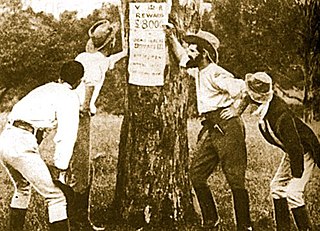
The year 1906 in film involved some significant events.
The year 1901 in film involved some significant events.
The following is an overview of the events of 1898 in film, including a list of films released and notable births. The Spanish–American War was a popular subject. Several films made by Col. William N. Selig dealt with the subject of war preparations at Camp Tanner in Springfield, Illinois, including Soldiers at Play, Wash Day in Camp and First Regiment Marching.
The following is an overview of the events of 1897 in film, including a list of films released and notable births.
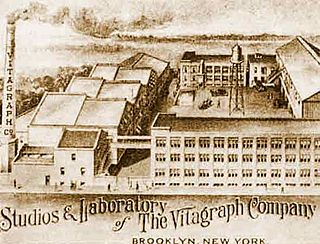
Vitagraph Studios, also known as the Vitagraph Company of America, was a United States motion picture studio. It was founded by J. Stuart Blackton and Albert E. Smith in 1897 in Brooklyn, New York, as the American Vitagraph Company. By 1907, it was the most prolific American film production company, producing many famous silent films. It was bought by Warner Bros. in 1925.
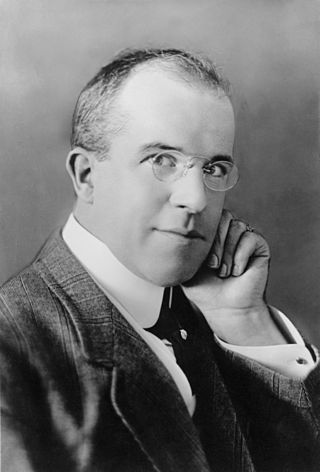
James Stuart Blackton was a British-American film producer and director of the silent era. One of the pioneers of motion pictures, he founded Vitagraph Studios in 1897. He was one of the first filmmakers to use the techniques of stop-motion and drawn animation, is considered a father of American animation, and was the first to bring many classic plays and books to the screen. Blackton was also the commodore of the Motorboat Club of America and the Atlantic Yacht Club.

Edison Studios was an American film production organization, owned by companies controlled by inventor and entrepreneur, Thomas Edison. The studio made close to 1,200 films, as part of the Edison Manufacturing Company (1894–1911) and then Thomas A. Edison, Inc. (1911–1918), until the studio's closing in 1918. Of that number, 54 were feature length, and the remainder were shorts. All of the company's films have fallen into the public domain because they were released before 1928.

Charles Morand Pathé was a pioneer of the French film and recording industries. As the founder of Pathé Frères, its roots lie in 1896 Paris, France, when Pathé and his brothers pioneered the development of the moving image. Pathé adopted the national emblem of France, the cockerel, as the trademark for his company. After the company, now called Compagnie Générale des Éstablissements Pathé Frères Phonographes & Cinématographes, invented the cinema newsreel with Pathé-Journal.
Ferdinand Zecca was a pioneer French film director, film producer, actor and screenwriter. He worked primarily for the Pathé company, first in artistic endeavors then in administration of the internationally based company.
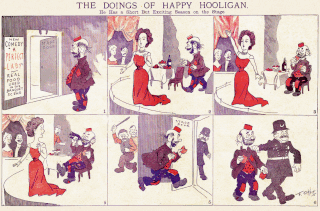
Happy Hooligan is an American comic strip, the first major strip by the already celebrated cartoonist Frederick Burr Opper. It debuted with a Sunday strip on March 11, 1900 in the William Randolph Hearst newspapers, and was one of the first popular comics with King Features Syndicate. The strip ran for three decades, ending on August 14, 1932.
The following is a list of films by Edwin S. Porter, head producer at the Edison Manufacturing Company owned by Thomas A. Edison, between 1900 and 1909. Later films were produced at the Rex Motion Picture Company and Famous Players Film Company.

Albert Edward Smith was an American stage magician, film director and producer, and a naturalized American. He founded Vitagraph Studios with his business partner James Stuart Blackton in 1897.

Éruption volcanique à la Martinique, released in the United States as The Eruption of Mount Pelee and in Britain as The Terrible Eruption of Mount Pelée and Destruction of St. Pierre, Martinique, is a 1902 French short silent film directed by Georges Méliès. The film is a short reconstruction, using miniature models, of a recent historical event: the eruption on 8 May 1902 of Mount Pelée, which destroyed the town of Saint-Pierre, Martinique.
Le Congrès des Nations en Chine, released in the US as China Versus Allied Powers and in the UK as China Versus the Allied Nations, and also known as The Congress of Nations in China: A Topical Creation and China Against the Allies, was a 1900 French silent satirical trick film directed by Georges Méliès. It was released by Méliès's Star Film Company and is numbered 327 in its catalogues.
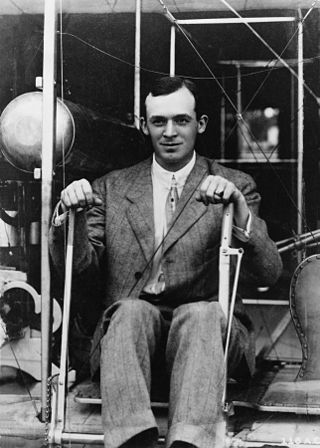
The Military Air-Scout (1911) is considered by some aviation film historians as one of the first aviation films recorded worldwide. William J. Humphrey directed the two-reeler in 1911, with the cooperation of the U.S. Army authorities who allowed Lt. Henry Arnold, a pioneer military pilot to carry out stunt flying for the film.
À la conquête de l'air is a 1901 French silent film directed by Ferdinand Zecca and distributed by Pathé Frères. Based on contemporary accounts of aviation developments, À la conquête de l'air stars Ferdinand Zecca as the pilot of a fantastic flying machine. Aviation film historian Michael Paris considered the film, the first French aviation film and among the first to feature an aircraft in flight.

The Airship, or 100 Years Hence is an American adventure comedy-drama silent short film written, produced and directed by J. Stuart Blackton. The film stars Blackton and Florence Lawrence. It was released on April 25, 1908 by The American Vitagraph Company; a partial print of The Airship, or 100 Years Hence is preserved in the Paper Print Collection. The Airship, or 100 Years Hence advertised that it would be "a forecast of a probable means of air navigation in the coming century."










